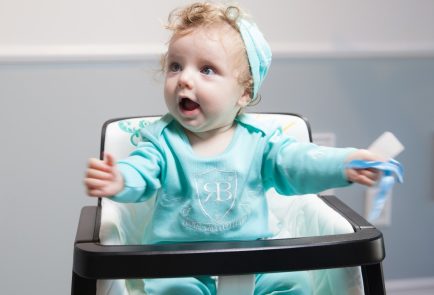Roseola leads to rashes on almost every part of the toddler’s body. A high fever precedes the emergence of the rash. And, it is only when the fever is gone that the rash appears. So, what causes roseola in toddlers? This MomJunction post provides you all the vital information about the viral disease.
Roseola, also known as exanthem subitum and sixth disease, is a viral disease caused by an infection from the human herpesvirus-6 (HHV-6) or the human herpesvirus-7 (HHV-7). HHV-6 is a more common cause of the disease than HHV-7 (1). Both HHV-6 and HHV-7 belong to the same family as the herpes simplex virus and the varicella-zoster virus that causes chickenpox and shingles (2). A baby of any age can get the disease, but it mostly affects infants and toddlers between 6 and 24 months (3).
The HHV-6 or the HHV-7 virus that causes roseola transmits through the nasal and oral route when a toddler inhales the virus. Transmission could happen when an infected person sneezes or coughs scattering tiny saliva and mucus droplets in the air. The virus can also land on surfaces. A toddler can catch the infection when he inhales the droplets or touches the contaminated surfaces and puts his hands in his mouth or nose.
Roseola is only contagious in the fever phase (4). By the time the toddler has a rash, the fever is gone, and the condition ceases to be contagious.
In the same way, a toddler contracts the virus on inhaling the sneeze/mucus droplets of an infected person’s sneeze or cough only when that person is in the fever stage. Coming in contact with the rash does not cause roseola because the rash does not transmit the virus.
In addition to fever and rashes, there are other signs that indicate the.
The incubation period for the roseola virus (both HHV-6 and HHV-7) is one to two weeks (5). A toddler will display the following symptoms of the condition (6):
High fever is the first symptom of the condition and comes without rashes. The roseola fever is on the higher side, at least 103°F (39.5°C) or above. The fever can last between three days and one week.
- Both eyelids swell making it difficult for the toddler to see.
- The toddler refuses to eat and might have a mild diarrhea.
- The baby may have a mild cold, runny nose, and a slight cough.
- General fussiness along with drowsiness.
Flat, pink rashes appear 12 to 24 hours after the fever has subsided. The rashes could be dark or light pink, and appear randomly scattered, but are not itchy and do not cause any discomfort. The rashes first appear on the chest and stomach followed by the back and other body parts. The face is the last place where the roseola rashes appear. The rash stage lasts for a few hours to three days. The toddler feels fine and appears healthy through the rash stage. But, do remember that if the condition goes untreated, it could lead to adverse effects. Roseola could have a few complications in toddlers.
Febrile seizures are seizures accompanied with high fever mostly in toddlers who are between 12 and 18 months (7)ᄃ. Since the seizures along with with a fever, they are called febrile seizures and are different from the seizures that occur during epilepsy. Febrile seizures happen only for a few minutes and rarely extend up to 15 minutes. During a seizure, the toddler’s limbs and body will twitch, shake, and he may roll awkwardly on the floor. While the situation could be unsettling for the parents, its occurrence is limited to high fevers. It is not known what causes febrile seizures, but are more common in toddlers with a family history of seizures, suggesting it could be a genetic problem.
Pneumonia, which is a bacterial infection of lungs, is quite likely to happen in toddlers who suffer from chronic lung infection or disease, and have contracted roseola too.
Encephalitis, the bacterial infection of the brain, is another complication that leads to severe pain and inflammation of the brain.
The condition should be attended to immediately and a through diagnosis becomes the first step to ridding the toddler of the disease.
Roseola can be difficult to diagnose as the initial symptoms resemble any other standard illness. Therefore, the doctor will suggest a blood test to check for the presence of the virus and its antibodies in the bloodstream.
If the diagnosis confirms roseola, the doctor suggests a treatment.
There is no treatment for roseola as it is caused by a virus (8)ᄃ. The roseola rash is not itchy, so the toddler will not need any topical ointments. Therefore, the medications provided only aim at bringing down the intensity of the fever. The doctor would prescribe analgesic (fever reducing) medicines such as acetaminophen or ibuprofen in a dosage suitable to the toddler’s age. Since there is no medication for roseola, managing the condition at home is important for the toddler to feel better.
The fever stage of roseola is the only time when the toddler is going to feel uncomfortable, and the below tips can help him feel better:
The toddler must be given plenty of fluids such as water and milk to prevent fatigue and dehydration due to high fever. For nourishment, provide liquid foods such as chicken broth and lentil soups.
Maintain a comfortable sleeping environment for the toddler to get sufficient rest.
Loose clothing ensures that the child does not feel hot when the fever goes high.
Sponging the baby is a safe home remedy for fever, recommended by experts (9)ᄃ. Place the toddler in the tub with shallow water between 85 to 90°F (29.4 to 32.2°C). Dip the sponge and gently rub the water across the torso, arms, and legs. As the water evaporates, it helps bring down the temperature.
A toddler recovers from roseola in seven to ten days since the onset of the fever. But, this condition can be prevented to ensure that the baby is healthy.
How To Prevent Roseola In Toddlers?
There is no vaccine against roseola (10)ᄃ. Also, the disease does not spread when coming in contact with the rash. Therefore, fever is the only stage where you have to be cautious. Therefore, keep the toddler away from people with high temperatures, and prevent accidental inhalation of mucus or saliva droplets expelled during sneezing or coughing. These measures will prevent roseola and its associated complications.
There are some more aspects of roseola that many parents would want to know about and we answer them below.
Frequently Asked Questions:
- Can a toddler get roseola twice?
Probably. If a toddler gets roseola from the HHV-6 virus, then he will build immunity against this strain of virus and will not develop roseola from HHV-6 again. If he is infected by the HHV-7, then he will build immunity against this strain, and not get roseola again from HIV-7. Thus, an infant will suffer from roseola twice only if he is affected by two different strains (11).
- Can I take the toddler outdoors when he is suffering from roseola?
Yes, but only in the rash stage of the disease. Do not take the toddler outdoors when he has a fever as the infection becomes contagious. If the toddler sneezes or coughs during the rash stage, he cannot transmit the virus to healthy individuals around. Since the rash does not spread roseola, it is safe to go outside during the rash stage of roseola.
- Can a toddler have roseola without a fever?
Yes. A toddler can have a roseola fever without a rash. It only happens when the HHV-6 virus causes roseola. The HHV-7 always causes roseola with fever followed by the rash.
- Can breastfed toddlers get roseola?
Yes. A toddler can catch roseola irrespective of his diet. However, breastmilk has been shown to offer some passive immunity against herpes virus family of viruses, provided the mother has been infected by the virus in the past (12). It does not guarantee protection, but breastfeeding your toddler can be a good way to boost his immunity (13).
Medical experts state that roseola is not very contagious and most often the disease goes away without medication and complications (14). It is still necessary to keep your toddler protected against it due to its ability to cause a high fever. Some simple prevention measures and proper hygiene are perhaps all that is needed to keep roseola miles away from your precious little one.
Original article: https://www.momjunction.com/articles/roseola-in-toddlers_00359380/































Comments